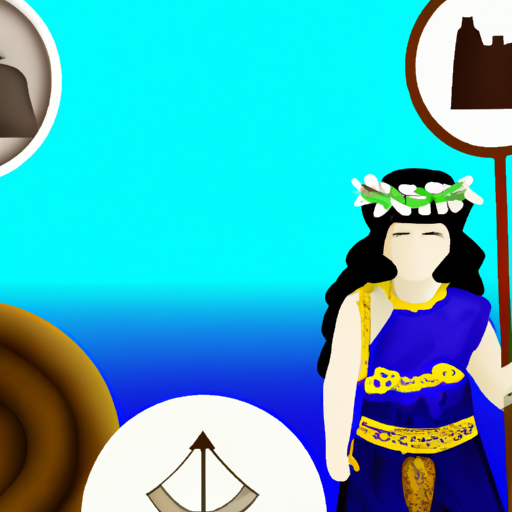Exploring the History of the Hanging Gardens: Do They Still Exist?
Unearth the past of the Hanging Gardens and discover if they endure in present times! What secrets may be unveiled? What stories have yet to be told? Is it possible these gardens still exist? Uncover the answers and explore a time long forgotten.

For centuries, the Hanging Gardens of Babylon have been shrouded in an enigmatic fog of curiosity and wonder. Supposedly crafted by King Nebuchadnezzar II around 600 BC, these gardens were purported to be one of the Seven Wonders of the Ancient World. But what was their true purpose? Was it a mere playground for royalty, or did they serve some other intent? And what happened to them after all this time?
Researching through antiquity, we know that the Hanging Gardens were situated in Babylon, a former city in today’s Iraq. It is said that they were an impressive accomplishment of engineering, consisting of stepped walls and adorned with exotic plants from far-off lands. Allegedly, water was pumped up from the river beneath to irrigate the gardens.
Rumor has it that during a siege on Babylon in 539 BC, the gardens were demolished. However, numerous historians refute this assumption. In fact, there is no definite proof that they ever existed! A few scholars believe that maybe these gardens were just a fabrication by Greek authors who wanted to romanticize Babylonian culture. Others speculate that possibly the Hanging Gardens did exist but deteriorated over time.
In spite of its mysterious past, there is still hope for discovering more about the Hanging Gardens. Archaeologists are currently striving to uncover further details about this legendary site and possibly even learn if these gardens still remain today!
.
Introduction

A perplexing fog of speculation and conjecture surrounds the Hanging Gardens of Babylon, one of the fabled Seven Wonders of the Ancient World. Despite the lack of archaeological evidence, there is a lingering belief that these gardens may have been real at one point in time. It is said that King Nebuchadnezzar II of Babylon constructed them in the 6th century BCE as an offering to his beloved Queen Amytis. Though this scenario has been accepted by some, many historians now believe these gardens were merely a figment of imagination. Whatever their origin may be, it is certain that they no longer exist today.
– Historical Significance of the Hanging Gardens
A marvel of engineering, the Hanging Gardens of Babylon have captivated imaginations since they were first constructed by King Nebuchadnezzar II around 600 B.C.E. as a gift to his wife, Queen Amytis. Located in what is now Iraq, the gardens were crafted with intricate terraces and irrigation systems that allowed plants to grow on multiple levels.
Though numerous ancient writers have documented the gardens, their exact location has never been found. Nonetheless, their legacy persists and they remain an important part of history.
The purpose of the gardens remains a mystery; some believe it was a royal retreat for Queen Amytis while others suggest it was meant to be an impressive display for visitors from other lands. Either way, its significance is profound; it showcases early engineering principles such as terrace building and irrigation that are still utilized today in certain parts of the world. Additionally, it serves as a reminder that even thousands of years ago humans could create something beautiful and enduring despite challenging environmental conditions.
Throughout time, the Hanging Gardens have become an iconic symbol in art and literature – a testament to human ingenuity even in difficult circumstances.
– Tracing the History of the Hanging Gardens
The history of the Hanging Gardens is a captivating journey through time, shrouded in mystery and debate. Though no archaeological evidence has surfaced to prove its existence, ancient texts from classical authors such as Strabo and Diodorus Siculus provide clues. Greek historian Herodotus described them as a wonder of the ancient world, with brick and bitumen terraces filled with earth, trees and shrubs irrigated by water pumped up from the Euphrates River. Cuneiform tablets found at Babylonian sites such as Nineveh and Susa also reference a large garden complex known as “the House of Heaven,” which may be an early reference to the legendary gardens. Despite its uncertain origin, the story of the Hanging Gardens has enthralled people for centuries – real or mythical, it remains one of history’s most enduring puzzles.
– Exploring Ancient Accounts of the Hanging Gardens
For centuries, the Hanging Gardens of Babylon have been an enigma, captivating the imaginations of many. But what was this ancient structure really like? To gain a better understanding, one must look to the historical accounts that have been passed down through time.
The earliest written account comes from Greek historian Berossus in 290 BC, who wrote that King Nebuchadnezzar constructed an artificial mountain with terraces filled with exotic plants and trees. This description implies that the gardens were not actually “hanging” but rather built into the side of a mountain or hill.
Greek historian Diodorus Siculus in 60 BC provided another version of the gardens, saying they were planted on top of a stage tower which was supported by pillars and arches. This could explain why there is so little archaeological evidence today.
The most detailed account came from Roman historian Pliny in 77 AD who described how the gardens were irrigated using water brought up from the Euphrates River via an elaborate system of aqueducts and pumps. He also noted that exotic plants, trees, and flowers were imported from far away lands such as India, Arabia, and Ethiopia to fill the terraced beds.
By delving into these ancient accounts, we can get a glimpse into what life was like in Babylon during this period and what kind of engineering feats were possible at this time. Although we may never know exactly how these gardens looked or how they were constructed, exploring these historical accounts allows us to appreciate their grandeur and mystery even more.
– Assessing the Evidence for the Existence of the Hanging Gardens
The enigmatic Hanging Gardens of Babylon, one of the Seven Wonders of the Ancient World, have remained shrouded in mystery for centuries. Historical records and archaeological discoveries offer little evidence to support their existence, leaving historians debating whether they were a myth or an actual ancient structure.
In the 4th century BC, Greek historians wrote about the gardens as if they were real. However, no physical remains have been found to corroborate this claim. Some believe that an earthquake in the 2nd century BC destroyed any evidence of their existence.
Cuneiform tablets uncovered from Babylonian ruins describe a complex system of irrigation canals used to water plants on high terraces; some scholars interpret this as proof that the Hanging Gardens existed, though it could also be attributed to other systems such as agricultural terraces or fish ponds. Additionally, paintings and sculptures depicting lush landscapes with trees and flowers could simply be artistic representations rather than depictions of a specific location.
Ultimately, there is still not enough evidence to conclusively determine whether or not the Hanging Gardens of Babylon ever existed. Regardless, their story continues to captivate people around the world and stands as an example of how history can be rewritten through mythology and legend.
– Examining Archaeological Findings Related to the Hanging Gardens
Mystery has swirled around the Hanging Gardens of Babylon for centuries, as one of the Seven Wonders of the Ancient World. Though there is no definitive proof that they ever existed, archaeologists have unearthed a number of artifacts related to them which can help us gain insight into this legendary structure. Cuneiform tablets from 600 BCE describe irrigation systems with channels built into walls, while sculptures and bas-reliefs depict terraced gardens filled with trees and shrubs. Additionally, written sources such as Greek historians offer valuable information about their size and layout as well as their purpose and function.
Exploring these findings can provide an invaluable look into a lost world – offering a glimpse into life in Babylon during this period of time. As more discoveries are made, our understanding of this ancient wonder will only continue to expand, unlocking even more secrets from its past.
conclusion

No, there is no longer any trace of the renowned Hanging Gardens of Babylon. A marvel of antiquity, these gardens have been lost to the mists of history for ages. Despite the many conjectures about their precise whereabouts, not a single shred of proof has been unearthed to suggest they still exist.
.
Some questions with answers
Q1. Do the hanging gardens still exist?
A1. No, the hanging gardens are no longer in existence.
Q2. What is the history of the hanging gardens?
A2. The Hanging Gardens of Babylon were one of the Seven Wonders of the Ancient World, believed to have been built around 600 BC by King Nebuchadnezzar II for his wife Amytis of Media.
Q3. Where were the hanging gardens located?
A3. The Hanging Gardens were located in Babylon, which is now modern day Iraq.
Q4. How did the hanging gardens get destroyed?
A4. It is not known for certain how or when exactly the Hanging Gardens were destroyed, but it is thought that they may have been damaged or destroyed by an earthquake in 539 BC when Babylon was conquered by Cyrus II of Persia and Alexander III of Macedon (Alexander the Great).
Q5. Are there any remnants from the hanging gardens remaining today?
A5. There are no visible remains from these gardens today as they have been lost over time due to natural disasters and other factors such as war and urban development in modern-day Iraq.




